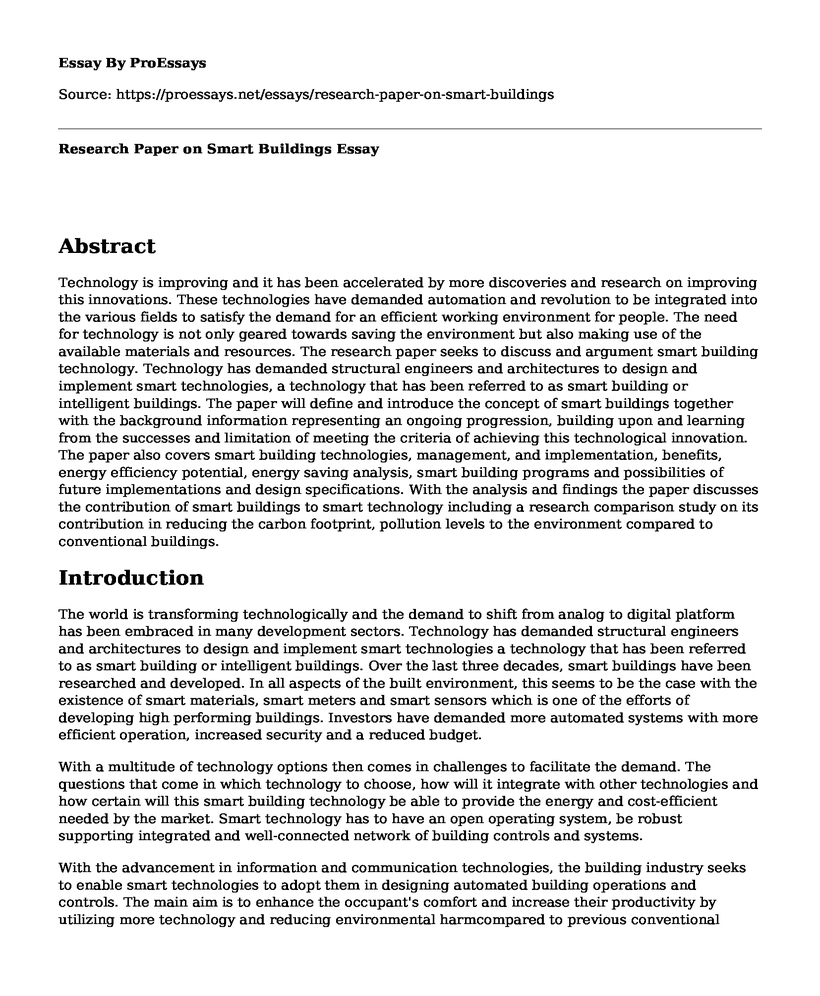Abstract
Technology is improving and it has been accelerated by more discoveries and research on improving this innovations. These technologies have demanded automation and revolution to be integrated into the various fields to satisfy the demand for an efficient working environment for people. The need for technology is not only geared towards saving the environment but also making use of the available materials and resources. The research paper seeks to discuss and argument smart building technology. Technology has demanded structural engineers and architectures to design and implement smart technologies, a technology that has been referred to as smart building or intelligent buildings. The paper will define and introduce the concept of smart buildings together with the background information representing an ongoing progression, building upon and learning from the successes and limitation of meeting the criteria of achieving this technological innovation. The paper also covers smart building technologies, management, and implementation, benefits, energy efficiency potential, energy saving analysis, smart building programs and possibilities of future implementations and design specifications. With the analysis and findings the paper discusses the contribution of smart buildings to smart technology including a research comparison study on its contribution in reducing the carbon footprint, pollution levels to the environment compared to conventional buildings.
Introduction
The world is transforming technologically and the demand to shift from analog to digital platform has been embraced in many development sectors. Technology has demanded structural engineers and architectures to design and implement smart technologies a technology that has been referred to as smart building or intelligent buildings. Over the last three decades, smart buildings have been researched and developed. In all aspects of the built environment, this seems to be the case with the existence of smart materials, smart meters and smart sensors which is one of the efforts of developing high performing buildings. Investors have demanded more automated systems with more efficient operation, increased security and a reduced budget.
With a multitude of technology options then comes in challenges to facilitate the demand. The questions that come in which technology to choose, how will it integrate with other technologies and how certain will this smart building technology be able to provide the energy and cost-efficient needed by the market. Smart technology has to have an open operating system, be robust supporting integrated and well-connected network of building controls and systems.
With the advancement in information and communication technologies, the building industry seeks to enable smart technologies to adopt them in designing automated building operations and controls. The main aim is to enhance the occupant's comfort and increase their productivity by utilizing more technology and reducing environmental harmcompared to previous conventional buildings. This will transform and change the nature of buildings. The main objective for traditional buildings was providing space to learn, live and work but the demand in recent times is that they have to be smart. The smart building has to provide and improve comforts for the occupants, communicate problems and use lower energy costs. Apart from the expectations that limit smart buildings within its concrete wall boundaries, they are also expected to work with the outside elements which includes the environmental conditions, electrical grids and the mission of their organizations.
The recent rush in technological innovation has demanded and accelerated change in how the buildings operate, adding a challenge to create a smarter building. Smart buildings are more than new technologies and software analytics, smart buildings need to start with an intelligent structure. An intelligent structure is defined by its open and robust operating system that supports integrated and a well-connected network of building controls and systems. It should also include a data analytics that turns data into meaningful information.
The evolution of smart building first emerged in the early 1980s but was extensively involved by use of elaborate centralized electronic systems that support building in support of communication systems of data in text and voice. This initial evolution transformed communication by limiting interactions between occupants and centralizing the word processing services using a user interface.
Many definitions were developed to define smart buildings. The first definition was presented by the United States Intelligent Building Institute that defined it as an intelligent building is one which provides a productive and cost-effective Environment through the optimization of its four basic elements systems, structure, services, management and the inter-relationship between them.The reference earlier was more of automation than intelligence whereby automation only concentrated on the optimal behavior while intelligent deals more with computer science and mathematics using extendedalgorithms which enables more thinking that will dramatically change parameters in order to optimize and anticipate expectations.
Since its creation in 1992, the intelligent building pyramid has become a landmark in its progress. The main aims on intelligent building pyramid were on the integration monitor systems, building c...
Cite this page
Research Paper on Smart Buildings. (2022, Jul 07). Retrieved from https://proessays.net/essays/research-paper-on-smart-buildings
If you are the original author of this essay and no longer wish to have it published on the ProEssays website, please click below to request its removal:
- Innovation Exploitation Report
- Essay Sample on Nanotechnology and Robo-Taxis
- Research Paper on Novel Use of Drone Technology and 3-D Numerical Modeling
- Essay on Transformation of the World: Technology, Ideas, and Literary Theory
- Article Analysis Essay on Moped Enabled Mobile Phone Snatches
- Essay Example on Airplane Electrical Power System: An Overview
- Global Tanker Sector: Analysis of 2019 Freight Movements - Essay Sample







